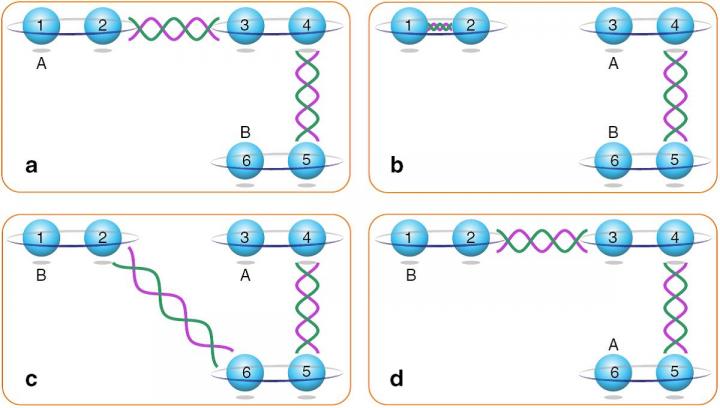

The braiding of Majorana zero modes is shown.
Image by LI et. al
In the condensed matter physics, scientists found a kind of quasiparticles —- Majorana zero modes (MZMs) —- have similar characters as Majorana fermions. Recently a research team from the Key Laboratory of Quantum Information of the Chinese Academy of Sciences made the achievement on fabrication and manipulation of MZM in an optical simulator.
The team led by Profs. LI Chuangfeng, XU Jinshi, and HAN Yongjian implement the exchange of two MZMs in which the non-Abelian statistics of MZMs is supported. This work is published on Nature Communications on October 25th.
Generally, the statistics of the identical particles can be determined by their exchange characters. For example, the internal quantum states remain the same when two bosons are exchanged, while they would be imposed by a \pi phase when two fermions are exchanged. The bosons and fermions belong to particles with a more general statistics which is named Abelian anyon. A global phase (not necessary 0 or \pi) is gained after the exchange of two identical Abelian anyons.
Moreover, there may exist some exotic particles, named non-Abelian anyon which will undertake an unitary transformation (not just a global phase) after exchange. The Majorana fermions with their own antiparticles are widely believed to be the non-Abelian particles.
The research team took the advantage of the quantum simulation approach: while the simulated system is not experimentally accessible with current technology, the quantum simulator and its measurement results provide information about the simulated system.
In their work, they designed a set of dissipative processes which can effectively create and transfer the MZMs supported in the Kitaev model. Then they finally completed the exchange of two MZMs. The measured Berry phase during the exchange process supports the non-Abelian statistics of MZMs. Furthermore, they demonstrate that the information encoded in the MZMs is immune against local noises in the linear optical system.
The method established here provides a novel way to study quantum statistics, topological quantum computation and the characters of MZMs. Moreover, this achievement establishes a promising platform to investigate the properties of the MZM in complex architectures and the topological quantum computation based on the MZMs.
###
This work was supported by the Ministry of Science and Technology of China, National Natural Science Foundation of China, The Chinese Academy of Sciences and Synergetic Innovation Center of Quantum Information and Quantum Physics.












